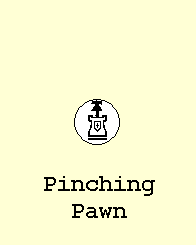For the best explanation of the rules (the 1963 version) see this page of the web site ChessVariants.org. Not only is their explanation well-written, but if you click on “Animated Illustration” you’ll see a series of moving diagrams that help explain the pieces (a sample is at the right). These are animated GIFs created by David Howe. They are a fantastic innovation for presenting game rules and could be used in other forms of technical writing. The Chess Variants site also has an interview with me.
Just in case you think there aren’t already enough descriptions of this game, I should point out that Wikipedia has a long entry titled Baroque chess. In addition to providing another description of Baroque, it also presents some Baroque Variants.
Back around 1964, I created a series of 12 Ultima puzzles. They were never published anywhere and I pretty much forgot about them, but recently one of my correspondents from the 60s, Lee H. Skinner, reminded me of them. I was able to put updated versions of the puzzles on this site, starting here. Both Lee and I consider the Ultima puzzles to be better than Ultima.
In 1988 I wrote an article about Ultima for Michael Keller’s magazine, World Game Review. I copied that entire article to this page of my site. It gives a good history of the game and it also explains the problems I saw in the game. After the article is a further discussion of ways the game could be improved.
